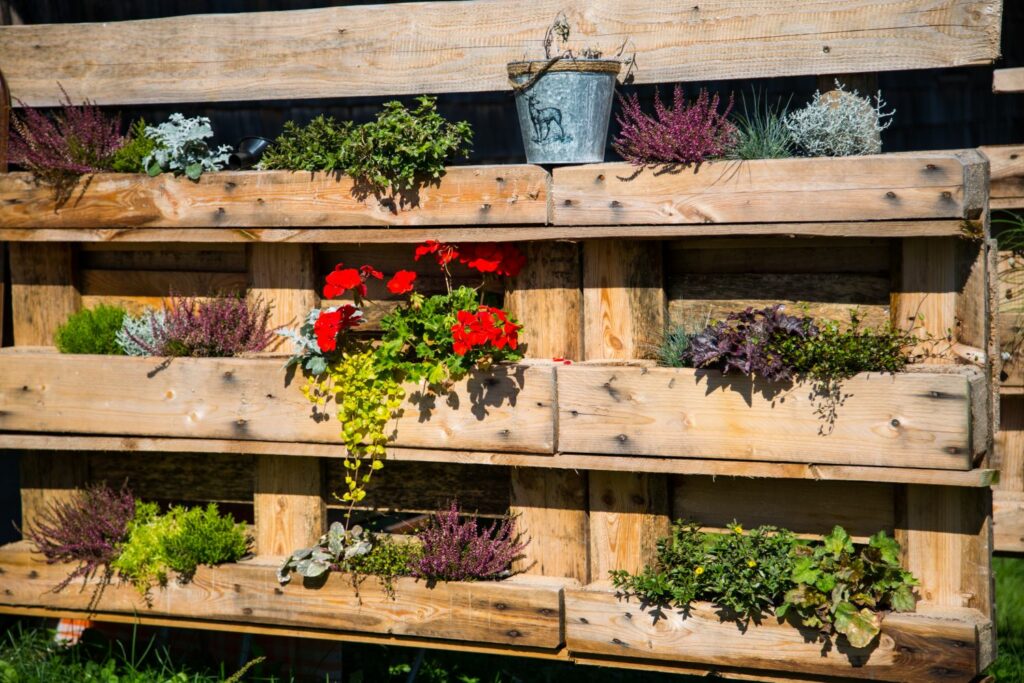
×

1. Pallet Vertical Garden: Create a vertical garden by attaching pallets to a wall or fence. Fill the pallet spaces with small pots or planters and grow herbs, succulents, or flowers. This not only saves space but also adds a lush, green backdrop to your outdoor space.
2. Pallet Garden Furniture: Craft pallets into outdoor furniture pieces like sofas, chairs, and coffee tables. Sand and paint them to match your preferred style, and add cushions and pillows for comfort. Pallet furniture adds a rustic and inviting feel to your garden.
3. Pallet Planters: Build various sizes of planters using pallet wood. These planters can be used for growing flowers, vegetables, or herbs. You can place them on the ground, hang them from a fence, or stack them for a vertical garden.
4. Pallet Pathway: Disassemble pallets and use the wooden planks to create a charming garden pathway. Lay them out in a herringbone or chevron pattern for an eye-catching design element.
5. Pallet Swing: Craft a cozy swing bed or a hanging chair using pallets. Suspend it from a sturdy tree branch or a pergola for a relaxing spot to enjoy your garden.
1. Pallet Condition: Start by examining the condition of the pallet. Look for pallets that are in good shape with minimal damage. Avoid those with broken or split boards, as these may not hold up well over time.
2. Pallet Type: There are two main types of pallets: hardwood and softwood. Hardwood pallets, typically made from oak or maple, are more durable and longer-lasting, making them ideal for outdoor projects like garden planters. Softwood pallets, made from pine or fir, may deteriorate more quickly but can still work if you plan to seal and protect them.
3. Pallet Size: Consider the size of the pallet in relation to your garden space and the planters you want to create. Smaller pallets are suitable for smaller planters, while larger pallets can accommodate more significant projects. Make sure the pallet size matches your design vision.
4. Pallet Treatment: Check whether the pallet has been treated with chemicals or pesticides. Avoid pallets that have been chemically treated, especially if you plan to grow edible plants in your planters. Look for pallets marked with HT (Heat Treated), as these have been heat-treated rather than chemically treated.
5. Pallet Design: Examine the pallet's design. Some pallets have wide or narrow spacing between the boards. The spacing should align with your planter's design and the types of plants you want to grow. Wider spacing allows for better drainage, while narrower spacing can support smaller plants and soil.

www.google.com
1. Retaining Walls: Retaining walls are not only practical for managing sloped landscapes but also serve as stunning garden features. Use natural stone, concrete blocks, or timber to build retaining walls that provide support for plant beds and create terraced levels in your garden.
2. Vertical Gardens: Transform a wall into a vertical garden by installing wall-mounted planters, trellises, or wire mesh grids. Grow climbing plants like ivy, roses, or vines to cover the surface, adding lush greenery and a touch of elegance.
3. Living Walls: Create living walls or green walls by covering an entire vertical surface with a variety of plants. Use modular systems or plant pockets to achieve a living wall that not only looks captivating but also contributes to improved air quality.
4. Water Features: Incorporate a water wall or fountain as part of your garden wall design. The sound of flowing water can be incredibly soothing, and it adds a tranquil atmosphere to your garden.
5. Mosaic or Tiled Walls: Decorate your garden wall with colorful mosaics or tiles. This artistic touch can infuse vibrancy and uniqueness into your outdoor space.
1. Wooden Pallet: Choose a pallet in good condition, preferably one that is heat-treated (marked with "HT") rather than chemically treated.
2. Landscaping Fabric or Weed Barrier: This will be used to line the pallet to prevent soil from falling through the gaps.
3. Staple Gun and Staples: For securing the landscaping fabric to the pallet.
4. Potting Soil: High-quality potting soil with good drainage is essential for healthy herb growth.
5. Herb Plants or Seeds: Select your favorite herbs, such as basil, rosemary, mint, thyme, oregano, and parsley. You can start from seeds or use established plants.
6. Paint and Brushes (Optional): To add a decorative touch to your pallet herb garden.
Read Also: Exploring the World of Terraced Garden Ideas

www.google.com
Herb garden pallet ideas and pallet vegetable garden ideas
1. Basil (Ocimum basilicum): Basil is a must-have herb for any pallet garden. It's easy to grow and adds a rich, aromatic flavor to pasta dishes, salads, and pizzas.
2. Rosemary (Rosmarinus officinalis): Rosemary is a hardy herb with fragrant, needle-like leaves.
3. Mint (Mentha spp.): Mint comes in various flavors like peppermint, spearmint, and chocolate mint. It's excellent for making refreshing teas, cocktails, and desserts. Mint is quite invasive, so consider planting it in a separate section of your pallet or use a container to prevent it from spreading.
4. Thyme (Thymus vulgaris): Thyme is a versatile herb that pairs well with a wide range of dishes, from soups and stews to roasted vegetables.
5. Oregano (Origanum vulgare): Oregano is a staple in Italian and Mediterranean cuisine. It complements tomato-based dishes, pizza, and grilled meats. Plant it in a sunny location with good air circulation.
By Anushikha bhatnagar
.